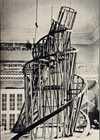Midterm Flashcards
(86 cards)

Henri Matisee, The Serf, 1900-1903 (1908 cast), bronze
- Inspired by Rodin’s Walking Man
- Idea of motion is not present
- Looks planted, frozen

Henri Matisse, Jeannette V, 1916, Bronze

Henri Matisse, The Back I, c. 1909, Bronze

Henri Matisse, The Back II, 1916, bronze

Henri Matisse, The Back III, 1916, bronze

Henri Matisse, The Back IV, 1931, bronze

Henri Matisse, Luxe, calme et volupté, 1904-05, oil on canvas
- Not a spontaneous placement of color, there is a study of the color
- Reference to Seurat’s A Sunday Afternoon, by the positioning and the stances of the people
- Conflation (collapsing) different inspiration from Seurat and Cezanne
- Not covering the entire canvas with paint; which is something that does not usually happen
- Different from Seurat in that Seurat puts colors right next to each other while Matisse shows canvas in between color
- Reclining female nude reference to Manet’s Olympia
- Clothed figures are a mother and a child wrapped in a towel
- Woman in child is Madame Matisse
- Wrapped child is Matisse’s son
- Nude- reference to the past, mythological
- Naked- a real person with no clothes

Henri Matisse, The Open Window, 1905, oil on canvas
- Fauve is a very short period
- No depth

Henri Matisse, The Woman with the Hat, 1905 oil on canvas
- Madame Matisse
- Color changes and represents different things; we know that the neck ends where it does because the color changes from orange to blue
- Showing how color can work in new ways, trying to experiment with space

Henri Matisse, Portrait of Madame Matisse, 1905, oil on canvas

Matisse, Le Bonheur de vivre (The Joy of Life), 1906, oil on canvas
- Manifesto, not just a painting
- Moving away from Fauvism
- Straight out of the tube color
- Figures look familiar from other works by him
- Lose gender in works; conflicted moment where social and formal (binaries?) come to play
- Dionysus scene; total free for all, people dancing, people relaxing

Picasso, Les Demoiselles d’Avignon, June, July 1907, oil on canvas
- Not Fauvist
- Not using full palette
- Distinct shapes using lines
- First moment where we have multiple perspectives interacting; suggesting you get different moments of observation collapsing into each other
- Figure in the center is lying down and not standing up; position she is in, she would not be able to stand
- Disegno
- Woman on the right; implication of Egypt
- Primitivism; Egypt, other
- Prostitutes
- Models are looking at you
Colorito- modeling things through color
Disegno- modeling things through line

Henri Matisse, Reclining Nude I (Auorora), 1907, bronze

André Derain, The Dance, 1905-06, oil and distemper on canvas
- Palette is the same colors
- People enjoying life; Dionysian

Henri Matisse, The Blue Nude: Souvenir of Biskra, 1907, oil on canvas
- Evoking Africa

Pablo Picasso, Portrait of Gertrude Stein, oil on canvas, 1906
- Conceptual collage of the face
- One of Picasso’s largest patrons

Henri Matisse, Dance II, 1910, oil on canvas
- A Russian commissioner wanted a painted size mural

Henri Matisse, Bathers with a Turtle, 1908, oil on canvas
- Models not looking at you; maybe not at anything that is in the plain
- Serene, no confrontation of the figures

Henri Matisse, Harmony in Red, 1908, oil on canvas
- Everything in the painting is activated; everything has a bold color
- Making evil of the “decorative”
- In reference to his La Desserte (Dinner Table)
- Still painting something representational while finding a way to stylize it

Gustav Klimt, Jurisprudence, 1903-7, oil on canvas
- Unfinished
- Mix of old and new
- Justice; woman in the middle on the top holding a scale
- Figures in the foreground; could be considered juries; justice is sleep, justice is too hard and punishable, justice is confused → if they were to be on jury
- Man with the octopus is the one being judged

Egon Schiele, Nude Self-Portrait in Gray with Open Mouth, 1910, gouache and black crayon on paper

Wassily Kandinsky, Cover for Der Blaue Reiter Almanac, 1911, watercolor, india ink and pencil
- Referencing St. George on a horse

Ernst Ludwig Kirchner, The Street, Dresden, 1908, oil on canvas
- The flat road is pink
- Black eyes
- Colors convey a feeling of unnatural light in an urban landscape,
- Flatness of the picture plane
- Diagonal up the left of the painting drawing us back into the picture
- Car is in the back of the painting; confusion and chaos

Franz Marc, The Fate of the Animals, 1913, oil on canvas
































































